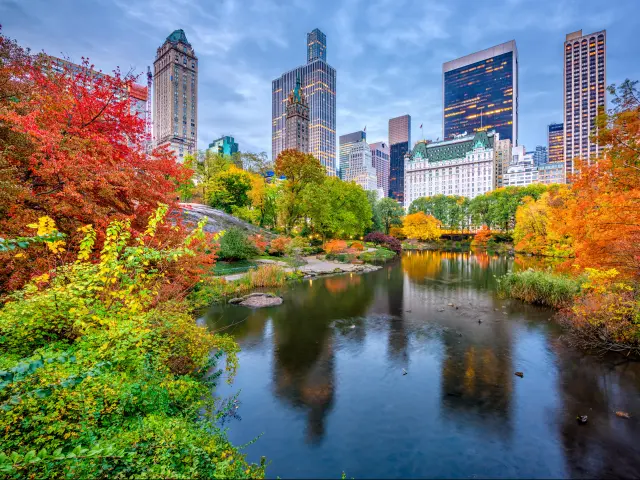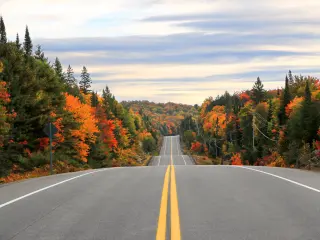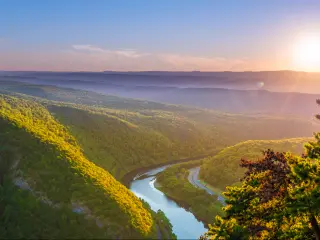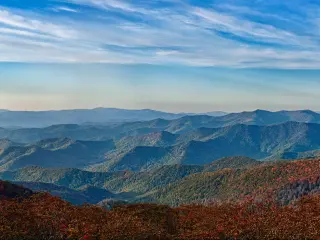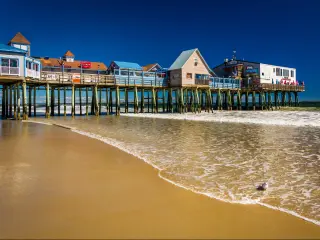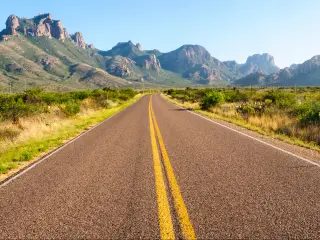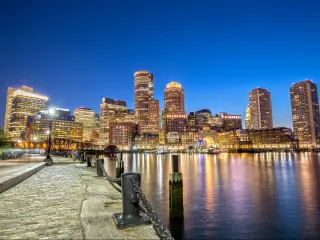Can you drive to New York City? Everything you need to know before taking your car to NYC
New York City is a beloved destination, both by domestic and foreign visitors, and the city is home to some of the nation's most well-known landmarks. While you can fly into the city to visit these, you might be wondering whether you can drive to New York instead.
Wherever you're starting from in the US, you can drive to New York City via the interstates. You'll have to juggle congestion, tolls and parking challenges though, and some travelers find that plane, train or bus are a more enjoyable way to travel.
Read on to find whether driving to New York City is the best option for you, the best ways to do so depending on which direction you are traveling from, and how to make your trip the most convenient and stress-free.
Can you drive to New York City?
Made up of the five boroughs of Manhattan, Brooklyn, Staten Island, Queens and The Bronx, New York City sits at the south of New York State, in the northeastern United States, where the Hudson River meets the Atlantic Ocean.
New York is well-connected via the interstate system, so if you look at a map, it appears easy to get to. Driving is the most direct way to reach NYC as you have a choice of routes depending on starting city and your destination in New York. You also won't have to take onward transit like you would with a train, plane or bus.

However, New York is famous for its congestion and busy roads. The interstate system around the city is notoriously unpredictable too and often slow – especially I-95.
Unless you're staying on the outskirts of the city, you'll also have to contend with challenging parking costs and restrictions on arrival. Add to this the cost of tolls and fuel and driving to New York City often works out as an expensive way to travel.
Put all this together, and you'll quickly see that, although it's possible to drive to New York City, this won't be the first choice for every traveler. To help you firm up plans for your trip, we've put together more information about driving to New York, along with some of the alternatives.
The major ways to travel to New York City
If you're driving to New York City, you'll almost certainly take one of the busy interstate routes heading to and through the city.
I-95 connects with New Jersey, Philadelphia, Washington DC and other destinations south of NYC. It also continues north out of NYC to reach New Haven, Providence and Boston.
For travelers starting upstate, I-87 heads south, following the Hudson Valley from Albany before joining up with I-287 as it makes its way through Rockland County and Westchester County before separating again and driving through the Bronx.
I-80, one of the longest west-east Interstates, starts in San Francisco and passes through or near major cities west of New York including Chicago, Cleveland and Salt Lake City. It ends a few miles short of NYC (in New Jersey) so you have to join up with I-95 to reach Manhattan.
If you're starting closer to New York, you also might find yourself traveling west on I-495 which connects Long Island with the city. Alternatively, I-78 travels through Pennsylvania and New Jersey.
In case you'd prefer not to drive to New York City, then keep on reading to find out about alternative plane, rail, and bus routes.
Driving to New York City from different directions
Unless you're planning a particularly slow-paced road trip, you'll probably use the interstate to reach New York City.
If you're starting out west of NYC, I-78 connects Allentown and other parts of central Pennsylvania. The route meets I-95 as it passes Newark International Airport, then crosses the Hudson River via the Lincoln Tunnel (I-495).
From Boston, the quickest route starts out on I-90 before switching onto I-84 to head towards Hartford then picking up I-91 for a few miles. Next you'll CT-15 S and follow it to the New York state line, which becomes the Hutchinson River Parkway.
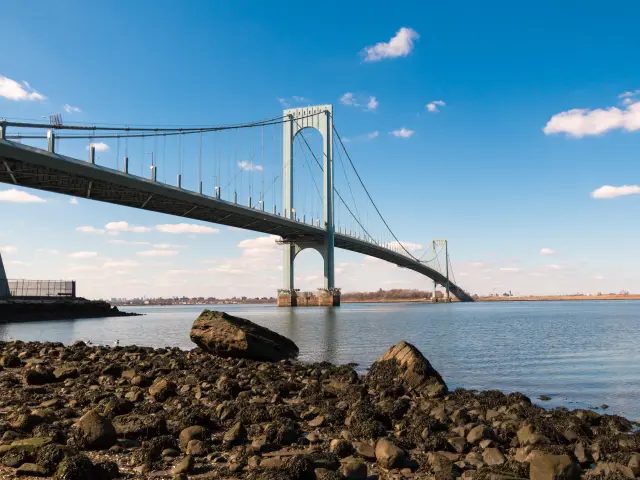
The next part of your route depends on your destination. If you're heading to Queens or Brooklyn, stay on the Hutchinson River Parkway and cross the Whitestone Bridge. Otherwise, switch to the Cross Country Parkway then Saw Mill River Parkway to join NY-9A which runs alongside the Hudson River to take you on to destinations in Manhattan.
If you're heading north to reach New York, chances are you'll join up with I-95 at some point before you reach the city. If you're starting out in Washington DC, Baltimore or Philadelphia, I-95 will take you all the way through New Jersey, then you'll turn onto I-495 to enter Manhattan via the Lincoln Tunnel.
For travelers who've spent time in upstate New York, head south from Syracuse on I-81, then use I-84/I-380 to join up with I-80. If your destination is in the north of NYC, stay on I-80 and follow signs for George Washington Bridge. If you're heading further south in Manhattan, turn off onto US-46 (signposted to Lincoln Tunnel) then join NY-3 which takes you to the Lincoln Tunnel and through to Manhattan.
| Origin City | Arrival point | Total Distance | Total Time |
|---|---|---|---|
| New Haven | Flushing Meadows Corona Park | 70 miles | 2 hours |
| Philadelphia | Empire State Building | 95 miles | 2 hours 10 minutes |
| Allentown | Empire State Building | 95 miles | 2 hours 15 minutes |
| Albany | Central Park | 150 miles | 2 hours 40 minutes |
| Baltimore | Empire State Building | 195 miles | 3 hours 30 minutes |
| Boston | Flushing Meadows Corona Park | 205 miles | 3 hours 40 minutes |
| Syracuse | New York Botanical Garden | 260 miles | 4 hours |
| Washington DC | Empire State Building | 240 miles | 4 hours 20 minutes |
| Pittsburgh | Central Park | 375 miles | 6 hours |
| Buffalo | New York Botanical Garden | 385 miles | 6 hours 20 minutes |
Where to arrive in New York City
New York City is such a huge destination that it pays to be clear on which part of the city you're heading to. This will influence the route you take to the city.
The city is separated from many surrounding areas by water, so unless you're traveling south from New England, most visitors will need to travel via either a bridge or tunnel to complete the drive to NYC.
The interstates and other major local highways converge on the George Washington Bridge, the Lincoln Tunnel, the Holland Tunnel, the Hugh L Carey Tunnel, the Brooklyn/Manhattan/Williamsburg Bridges, the Queens-Midtown Tunnel, and the Queensboro Bridge.
Elsewhere in the city, the Robert F Kennedy, Whitestone and Throgs Neck Bridges travel between the Bronx and Queens, while the Verrazano Narrows Bridge connects Brooklyn and Staten Island.
Is driving to New York City challenging?
There's no avoiding the fact that driving to and around NYC is often challenging as you get closer to the metropolis. I-95, in particular, is notorious for delays, but high traffic levels and frequent on and off-ramps mean that you'll have to pay close attention when you're driving on any of the interstates approaching the city.
Once you reach the city, the roads are busy, the grid system can be confusing if you find yourself in the wrong lane as you approach a turn, parking is expensive and hard to find.
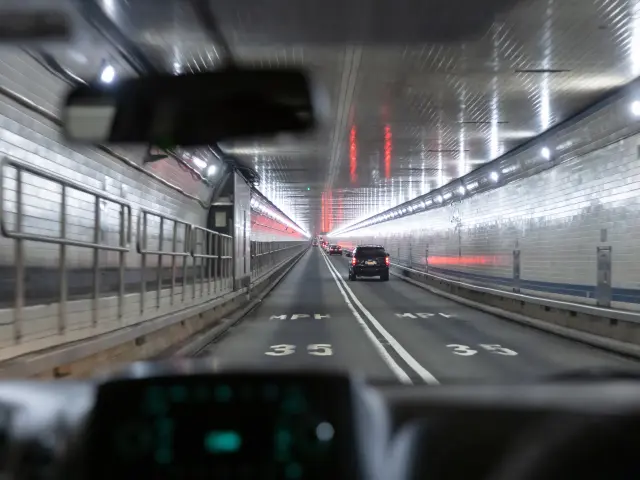
Traffic is always busy in New York, but expect even slower journey times during rush hour, which typically runs from 7am to 10am then 4pm to 7pm. As you might expect, traffic is more congested heading into Manhattan in the mornings, and away in the evenings.
Some of the interstates approaching New York City also charge tolls, and if you're covering a longer distance, these could total a significant amount.
On I-95, there's a small charge to use the New England Throughway into the Bronx and a fee of around $15 to take the New Jersey Turnpike towards George Washington Bridge. Travelers using I-87 will encounter tolls on the New York Thruway between Albany and NYC.
Some of the tunnels and bridges also charge a toll of at least $6 for a car, rising to more than $12 for the Holland Tunnel. You'll pay each way on the bridges between the Bronx and Queens: the Verrazano Narrows Bridge, the Queens-Midtown Tunnel, and the Hugh L Carey Tunnel.
Please keep in mind that these prices are calculated at the time of writing, and are subject to change.
If you're traveling through New Jersey, you'll pay a toll to drive through the Lincoln Tunnel - but it's free to drive back into New Jersey.
Most bridges and tunnels don't accept cash payment, so you need either an EZ Pass or an online account. If traveling in a rental car, check payment options with the rental company.
Another thing that will push up the cost of driving in New York is the congestion charge, which is due to be introduced in Manhattan (below 61st Street) in 2024.
Alternatives to driving yourself to New York City
Driving to New York City gives you the flexibility to leave when you like, take as much baggage as you need, and stop along the way. However, as you've already learned, it's not the most relaxing way to visit the Big Apple.
If you've read this far and decided against driving to New York, the great news is that it's a very walkable destination that you don't really need a car to enjoy. The grid system makes Manhattan easy to navigate, and it's possible to take the subway or a bus when you want to cover longer distances.
You have a number of alternative options if you decide to take your trip to New York City without a car. Of course, the best option depends on where you're starting from and what you're looking for on your trip.
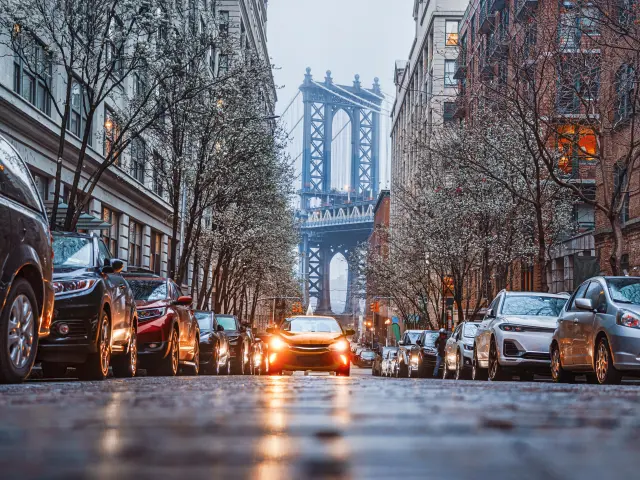
For journeys on the east coast then bus or train is a good alternative to driving and means you won't have to worry about parking once in the city.
Buses can be infrequent, and departure times are sometimes early in the morning or late at night, but at least you'll be able to sit back and relax while a professional takes on New York's busy roads.
Travel time is usually similar to the journey time if you're driving yourself. It's around 2 hours from Allentown, 4 to 5 hours from Boston or Washington DC, and 10 to 12 hours if you're coming from Toronto. Of course, buses can also be slowed down by many of the delays you would encounter if you were taking your own car.
If you're starting on the east coast then don't rule out taking the train. The journey from Washington DC can be as quick as 2 hours 45 minutes, whereas it will take 4 to 5 hours from Boston or around 8 hours from Buffalo.
Longer journeys are much slower and are often indirect. For example, it takes over 20 hours to hop between Chicago and New York by train, whilst Florida is more than a day away.
That means it's almost always more convenient to fly if you're starting out further afield. New York is served by a number of international airports offering hundreds of daily connections with other parts of the US and beyond.
John F Kennedy Airport in Queens is connected to the city by subway, while it's possible to take the train from Newark (New Jersey) into the city. La Guardia is a little harder to reach from the city, as you'll need to take a bus service that links up with the NY subway.
If you're combining a visit to NYC with a longer road trip, consider picking up and returning your rental car at the airport and sticking to public transport to get in and out of the city. That way you avoid all the driving challenges you've learned about!
Best time to drive to New York City
New York is a year-round destination but, depending on where you're traveling from, there will be seasonal variations. Snow and icy conditions are possible in the winter, especially if your journey begins north of NYC.
Travelers flock to NYC all year round so there's never really a quiet time to visit. With summer vacations, the city is busy from June to August but can be hot, humid and crowded – there are better times to visit if you have the choice.
Many travelers would say that spring or fall are the best times to visit. Spring starts off cool, with temperatures rising to the low 70s Fahrenheit by May. It's the perfect season to enjoy time outside by the riverside or in Central Park while cherry blossoms bloom and foliage burst back to life.

In fall, the temperature sits in the mid-60s to mid-70s in September and October, cooling down as the season progresses. Later in the fall, you can see the colorful foliage in Central Park, which is also a great time for special events.
See the city decorated for Halloween or watch the Macy's Thanksgiving Parade - but keep in mind that the city will be much busier over Thanksgiving than other parts of the fall.
Whatever time of year you travel, major roads approaching the city are always busy, with significant rush hour congestion. Once you're in the city, traffic is particularly congested in Manhattan during the holiday season, which runs right through November and December.
Once the Christmas season is out of the way, winter is usually the cheapest time to travel. There are often better rates on hotels and, with many indoor attractions and fantastic restaurants, you can have a great trip to New York even if the weather is cold and wet.
Things you need to know about driving to New York
If you've made the decision to drive to New York City, there are a few more things you need to keep in mind once you arrive in the Big Apple.
- Speed limits on the interstate are usually 55 to 65 MPH but can be lower on busy urban sections of the road.
- Within New York City the speed limit drops to just 25 MPH unless signs show otherwise. Always check for (and follow) signage.
- Speed limits are gradually being reduced on other major roads through NYC, so keep an eye on signage even if you've driven in the city before.
- Parking is expensive in New York City, and can be hard to find. Parking garages are often the best option if you're spending more than a few hours in the city.
- If you find on-street parking, pay attention to any signage, and don't forget to pay at the meter before you walk away. Some blocks have no parking periods during the day.
- Don't park in front of a fire hydrant or within 15 feet of one. You risk being towed. Again, watch out for signage but leave plenty of space if in doubt.
- Never park on crosswalks.
- Unlike other parts of the country and state, in New York City you must not turn right at a red light unless there's a sign to say it's permitted. Wait for the green light or green arrow instead.
- Always give way to emergency vehicles – whether they're moving or have already stopped.
- If your vehicle is in parking gear, then you've parked – don't do this where there are no parking signs.
- You can very briefly pause to pick up or drop off passengers at a no-standing sign, but the driver must remain in the car and can't wait for passengers to arrive.
- If in doubt, find somewhere else to stop if your passengers want to exit. Finally, and most straightforward, no stopping means no stopping.
